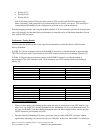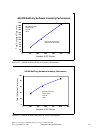
files of differing characteristics are being accessed. The pool attribute can be changed from *FIXED to
*CALC and back at any time, so making a change and evaluating its affect over a period of time is a
fairly safe experiment.
More information about Expert Cache can be found in the Work Management guide.
In some situations, you may find that you can achieve better memory utilization by defining the caching
characteristics yourself, rather than relying on the system algorithms. This can be done using the
QWCCHGTN (Change Pool Tuning Information) API, which is described in the Work Management API
reference manual. This API was provided prior to the offering of the *CALC option for the system. It is
still available for use, although most situations will see relatively little improvement over the *CALC
option and it is quite possible to achieve less improvement than with *CALC. When the API is used to
adjust the pool attribute, the value that is shown for the pool is USRDFN (user defined).
SETOBJACC (Set Object Access)
In some cases, the object access performance is improved when the user manually defines (names a
specific object) which object is placed into main storage. This can be achieved with the SETOBJACC
command. This command will clear any pages of an object that are in other storage pools and moves the
object to the specified pool. If the object is larger than the pool, the first portions of the object are
replaced with the later pages that are moved into the pool. The command reports on the current amount of
storage that is used in the pool.
If SETOBJACC is used when the QPFRADJ system value is set to either 2 or 3, the pool that is used to
hold the object should be a private pool so that the dynamic adjustment algorithms do not shrink the pool
because of the lack of job activity in the pool.
Large Memory Systems
Normally, you will use memory pools to separate specific sets of work, leaving all jobs which do a similar
activity in the same memory pool. With today's ability to configure many gigabytes of mainstore, you
may also find that work can be done more efficiently if you divide large groups of similar jobs into
separate memory pools. This may allow for more efficient operation of the algorithms which need to
search the pool for the best candidates to purge when new data is being brought in. Laboratory
experiments using the I/O intensive CPW workload on a fully configured 24-way system have shown
about a 2% improvement in CPU utilization when the transaction jobs were split among pools of about
16GB each, rather than all running in a single memory pool.
19.6 User Pool Faulting Guidelines
Due to the large range of AS/400 processors and due to an ever increasing variance in the complexity of
user applications, paging guidelines for user pools are no longer published. Even the system wide
guidelines are just that...guidelines. Each customer needs to track response time, throughput, and cpu
utilization against the paging rates to determine a reasonable paging rate.
There are two choices for tuning user pools:
1. Set system value QPFRADJ = 2 or 3, as described earlier in this chapter.
2. Manual tuning. Move storage around until the response times and throughputs are acceptable. The
rest of this section deals with how to determine these acceptable levels.
IBM i 6.1 Performance Capabilities Reference - January/April/October 2008
© Copyright IBM Corp. 2008 Chapter 19 - Misc Perf Information 308


















